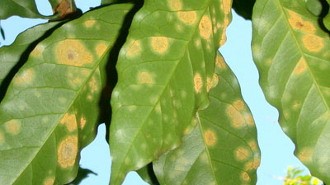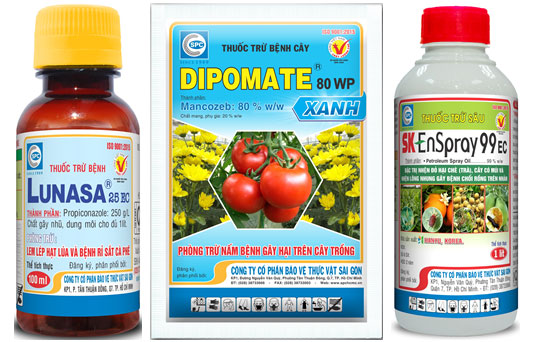|
Coffee Damaging Rust Disease
08/09/2021
Ph.D. Nguyen Minh Tuyen Rust often appears to cause damage on coffee gardens during the rainy season, and is often evident in the months from the beginning of the rainy season. The disease causes mass defoliation, severely affecting yield, if not paying attention to prevention. Symptoms
The disease mainly affects the leaves of coffee trees. Initially, the lesion is a small dot on the underside of the leaf, oval in shape with a pale yellow color, then the lesion grows larger. Large lesions can reach 1cm in diameter. The surface of the disease is covered with a thin layer of yellow-green or orange-yellow powder. When the disease is severe, a number of lesions can link together to form patches of yellowed leaves, dry burning and may fall off in bulk. The gardens with a lot of fallen leaves have poor growth and significantly reduced yield. Harmful agents and growing conditions: Disease caused by the Hemileia sp fungus. cause. The disease usually arises in the rainy season, especially in the months of heavy rain and humidity. In cool and high humidity conditions, it is very suitable for fungal growth. Therefore, in the Central Highlands, the disease often occurs and thrives in the rainy season, in the northern provinces, the disease develops in the cool months of autumn and the months from mid to late spring. The disease also thrives in the condition that coffee gardens are over-fertilized with nitrogen fertilizers, are dense, weeds are abundant etc... Some preventive measures: - Plant coffee at an appropriate density, avoid planting thick to ensure ventilation. - It is necessary to have a drainage system to drain water well after rain and avoid dampness. - During the rainy season, regularly clean the garden, except for weeds and prune dead and ineffective branches hidden in the canopy to create ventilation in the garden. - Fertilize to avoid excess nitrogen, because it will make the garden dense and susceptible to disease. Should use more foliar fertilizers such as SPC-K, or TANO-601 micro-fertilizer, spread SPC-CAL fertilizer to improve the soil. These fertilizers will help strengthen the plant is disease resistance, while increasing the yield and quality of coffee. - In rainy months, it is necessary to preventively spray the room with LUNASA 25EC, or DIPOMAT 80WP. Pay attention to wet the entire canopy and branches to prevent disease. Mainly preventively spray in the rainy season, 1-2 weeks / 1 time depending on the weather situation and disease. - Regularly check the garden during the rainy season to detect diseases and handle them promptly, in order to reduce damage and reduce prevention costs. Particular attention should be paid to orchards with a history of infection. - When the plants are infected, it is necessary to spray LUNASA 25EC or DIPOMATE 80WP in time. The product can be combined with SK ENSPRAY 99EC mineral oil to increase and prolong the effect in the rainy season. |
To prevent, in addition to plowing and burying weed seeds, collecting weed stalks and stumps left after tilling the land to burn, not letting weeds produce seeds in production fields, etc., the use of chemical products is still a measure. optimal because of its ability to thoroughly kill weeds, reduce labor and take advantage of more time than manual weeding.
Miner has the scientific name Phyllocnistis citrella Staint., family Phyllocnistidae, order Lepidoptera. The miner occurs in many countries in the tropics and subtropics. The main host of the miner is the citrus family - Rutaceae. In addition, the miner also attacks mangosteen and some other plants.
Adult is a small planthopper, with a body 2-3 mm long, the whole body is ash gray, slightly greenish, the wings are opaque with many small brown spots.Eggs are oval, 0.3 mm long, have a pointed end and are attached directly to the leaf surface, leaf axils.
Green bugs specialize in the fruit of citrus groups (oranges, tangerines, lemons, grapefruits, kumquats...), some people call them orange bugs, or orange suckers. Their scientific name is Rhynchocoris poseidon or Rhynchocoris humeralis.
In Vietnam, yellow leaf curl disease is very common on papaya trees, especially the disease is often severe in areas of high and continuous planting, areas with hot and arid climates. The disease has significantly reduced the yield and quality of papaya. Gardens that are infected early when the plants are young may not yield. However, up to now, many gardeners still do not know the cause and how to fix it.
Spider mites are common pests on citrus trees, especially in hot and dry climates that are suitable for spiders to grow and cause severe damage.The group of harmful spiders is usually very small in size, unlike the natural enemy spiders.
This group includes species that are generally very small in size, causing damage by sucking plant sap (on leaves, fruits, branches, stems).
There are many species of mealybugs present on the group of Oranges,Tangerines,Grapefruits and Lemons (Citrus), which can be divided into 2 groups:
+ Group of sticky mealybugs with common varieties such as Lepidosaphes, Aonidiella, Coccus and Saissetia.
+ Group of flower mealybugs with common genera and species such as Pseudococcus, Planococcus and Icerya purchasi.
Dry branches and berries disease often appear to be common damage on coffee gardens during the rainy season. The disease causes death of branchs, dry fruit, severely affects the canopy structure and coffee yield if not paid attention to prevention.
Pink disease commonly causes diseases on rubber plantations in the rainy season, especially on garden from 4-8 years old. This year, rubber has to go through a period of severe drought, weakening the tree, so now in tnshe rainy season it is easy to get infected. Therefore, it is necessary to pay attention to good management to avoid affecting the garden.
In recent years, the area of citrus has been expanded because it is a fruit tree with high economic efficiency. However, in order to sell at a high price, not only in quality but consumers also require the external beauty of the fruit, so pest management on citrus is a matter of great concern to farmers. The hot season is a favorable condition for thrips to develop and cause damage, affecting the commercial value of fruit.
- Headquarters
- SAIGON PLANT PROTECTION JOINT STOCK COMPANY
- RQ 1, Nguyen Van Quy St., Tan Thuan Ward, HCM City
- Tax code: 0300632232
- Tel: (028) 38 733 295 - 38 732 077
- Fax: (028) 38 733 003 - 38 733 391
- Website: www.spchcmc.vn - Email: info@spchcmc.vn
- SAIGON PLANT PROTECTION COMPANY
- SAIGON PLANT PROTECTION JOINT STOCK ENTERPRISE
- Lot C1-C3 Hiep Phuoc Industrial Park, Hiep Phuoc Commune, HCM City
- Tel: (028) 3873 4089 - Fax: (028) 3873 4086
- Affiliated Unit
-
- Quick Links
- Home
- About us
- Career Opportunities













